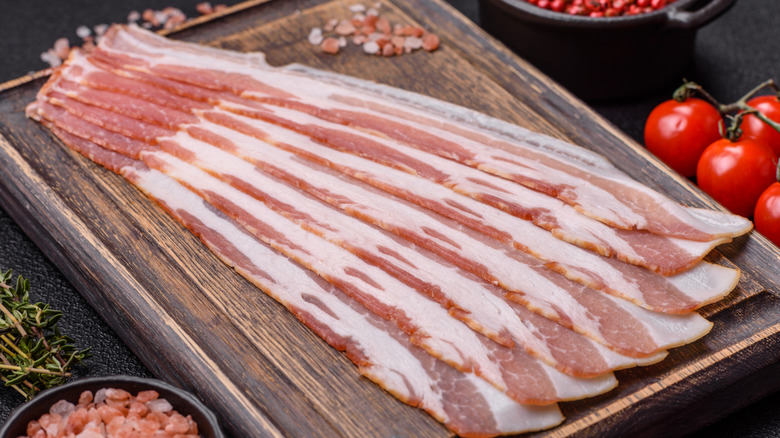Is Bacon Considered Processed Meat? Here's What To Know
Over the years, processed meat has developed a rough reputation, which is why no one eats this once-popular deli meat anymore – olive loaf. It's become a sort of umbrella term, and anything under it is associated with lacking any nutritional benefits — but this isn't always the case. This term encompasses a wide spectrum of foods and preservation methods, including some everyday favourites like bacon. The only reason bacon's considered processed is that it undergoes curing.
So what's the definition of processed meat? According to the World Health Organization, "Processed meat refers to meat that has been transformed through salting, curing, fermentation, smoking, or other processes to enhance flavour or improve preservation." This means that it's not a prerequisite for the meat to undergo specific chemical treatment to be considered processed. This definition encompasses a wide spectrum of foods, from fermented kimchi, delicious Alpine-style charcuterie to a salt-brined steak, all of which have vastly different nutritional profiles.
Bacon is considered processed as it undergoes curing and smoking. It typically starts its journey as pork belly (although Canadians prefer pork loin). This is then cured in one of two ways: It can be dry-cured, which involves a mixture of salt, sugar, and seasonings being rubbed directly on the pork and left in a refrigerated environment. It can also be wet-cured, which is when it's submerged in a salt water solution (brine), or injected directly with the brine. Optionally, the bacon can also be smoked following curing. It's placed in a smoker, and a low-temperature, hardwood smoke is used to add extra color and flavor. Following this, the pork belly is then sliced into the familiar strips we know and love today.
Cured versus uncured bacon
Common processing methods like curing, smoking, and fermenting are traditional, millennia-old preservation and flavor-enhancing methods that were necessary without modern appliances like refrigerators to keep food safe to eat. So why has it developed a bad rep today? There's a wide spectrum of processed meats, and some contain more additives and fillers than others. But if you're looking for a processed-free alternative to bacon, will uncured bacon fit the bill? Technically, no — all bacon, whether "cured" or "uncured," is still cured – it's just the ingredients that differ.
Usually, a standard batch of cured bacon will use added chemical curing agents, such as the inorganic compound sodium nitrite. These nitrites are essential for the curing processes and preserve the bacon, keep its color pink, and inhibit the growth of dangerous bacteria. While essential for extending the shelf-life of bacon and giving it its characteristic bacon flavor, nitrites have become a hot topic these days. This is because when they undergo high-heat cooking, they have been shown to convert into carcinogenic compounds, which is a huge part of processed meats' bad rep. This is why you'll also find uncured bacon being sold, which still undergoes curing and smoking but without the addition of sodium nitrite, so it's marketed as the more "natural" alternative to cured bacon. Instead of sodium nitrite, it opts for natural sources of nitrites like celery powder. But as these natural ingredients also contain nitrites, they'll still be converted into the same compounds as standard bacon when cooked or fried.


